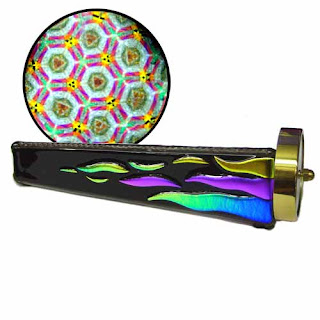 I used to make kaleidoscopes out of colored glass and first surface mirrors. These are not cheap projects, as the first surface mirrors were a bit pricey. You also needed all the solder, glass cutters, soldering iron, work surface and time that you would need for any other kind of leaded glass project.
I used to make kaleidoscopes out of colored glass and first surface mirrors. These are not cheap projects, as the first surface mirrors were a bit pricey. You also needed all the solder, glass cutters, soldering iron, work surface and time that you would need for any other kind of leaded glass project.
It isn’t stained glass, as that is the kind of stuff that has an image, like you see in old church windows. Leaded glass is just stained glass without the pictures.
My kaleidoscopes were pretty simple, three straight triangular tubes with a couple of wheels of colored glass at one end. I used marbled mirrors on the outside and a lot of solder to try and make it look smooth and neat. But they were pretty crude affairs and never lived up to the fine artistry of the books I bought at the glass shop. These were minor works of art made of curved woods of three different colors and some were encased in brass tubes and others looked like they had been hand blown.
It was not surprising that these kaleidoscopes cost anywhere from a few hundred to a few thousand dollars. The trick, of course, was finding someone will to pay those prices.
The images change radically depending on how the mirrors are aligned toward each other. Some people have patented processes that make the image appear three dimensional or appear to be surrounded by odd shaped boxes or have nails protruding from the center image. I did good to make my image look like the simple cardboard tubes from my childhood.
Still, it is fun to play around with once in a while. Making kaleidoscopes is easier than most forms of leaded glass work, in that you don’t need large sheets of glass to work with. The largest bits you are likely to need are for the tube covering, and even they can be broken into many smaller segments if that is all that you want. The most expensive bit is the first surface mirrors, which are needed for the best clarity and images in the tubes. But plain old mirror from Home Depot that come in 12 inch squares will work good enough for playing around purposes.
It’s all in the angles. The tighter the triangle, the more slices the image will have and usually the more intricate the detail. Open it up and it is more of a random field without that much structure, but still very pretty.
Like Juggling, there is this theory that looking at a kaleidoscope will mellow you out and make you a happier you. I don’t know if there is any benefits to looking at the random and ever changing pattern of a glass kaleidoscope, but I do know that the brain is stimulated by new and interesting things, so why not?
Hey, it couldn’t hurt. Try this little online kaleidoscope.
- Starfield – A Few Months In - December 23, 2023
- Still Just A Geek by Wil Wheaton - November 1, 2022
- Starfield First Impressions of Gameplay Reveal - June 13, 2022